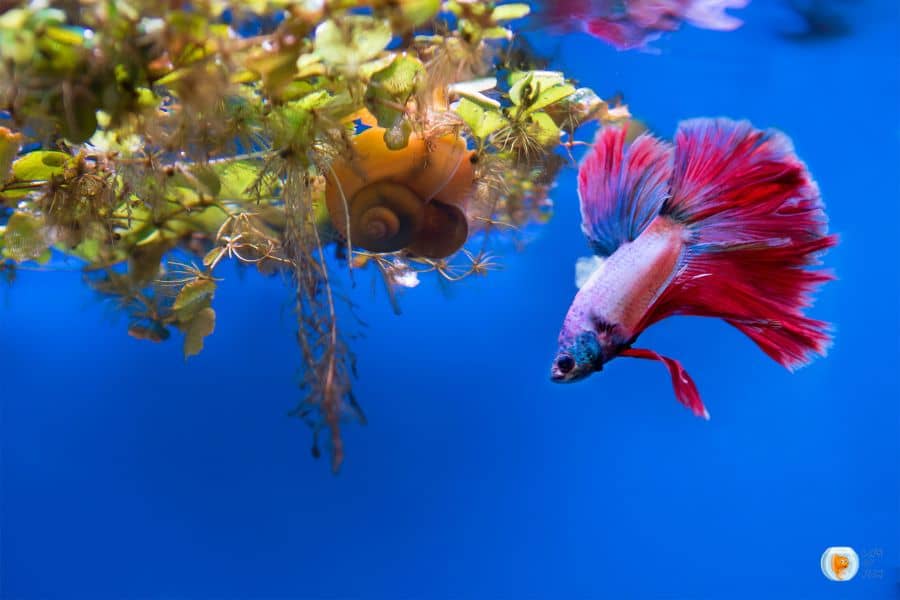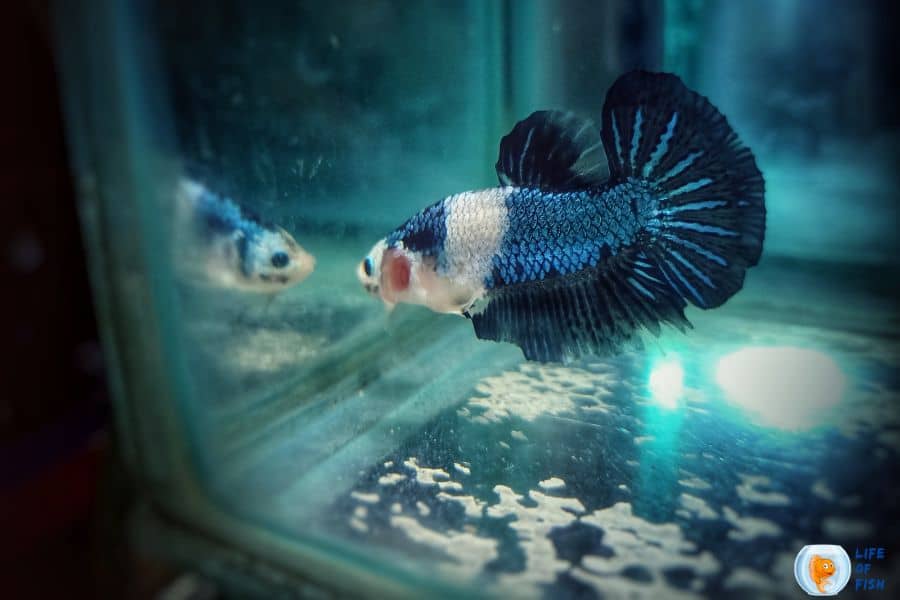Columnaris betta disease is a highly contagious bacterial infection that affects the tissue of betta fish. As such, it is extremely important for aquarium owners to be aware of the signs, symptoms and treatments associated with this potentially deadly condition.

This article will provide an overview of what columnaris betta disease is, how it spreads, its common symptoms and treatment options available. We’ll also discuss some preventative measures you can take as an aquarium owner to help protect your fish from contracting this disease.
“Are you concerned about the health of your Betta Fish? Learn how to diagnose and treat common Betta Fish Diseases by checking out our informative guide here.” Betta Fish Diseases
What Is Columnaris Betta Disease?
Jump To
- 1 What Is Columnaris Betta Disease?
- 2 Where Columnaris Betta Disease Comes From
- 3 Symptoms Of Columnaris In Bettas
- 4 How Columnaris Betta Disease Spreads
- 5 Can Columnaris Infect An Already Sick Betta Fish?
- 6 How To Treat Columnaris In Betta Fish
- 7 How To Prevent Columnaris In Your Betta Fish Tank
- 8 Is Columnaris Betta Disease Fatal?
- 9 What Causes Columnaris?
- 10 Is Columnaris Transferable To Humans?
- 11 How Long Can A Fish Live With Columnaris?
- 12 How Long Does Columnaris Live Without A Host?
- 13 Conclusion
Columnaris is a bacterial disease that affects many species of fish, including bettas. Flavobacterium columnare is the reason for this disease. It is an organism that lives in most aquatic environments and can infect any freshwater or marine fish kept in captivity.
Columnaris is a serious condition and it often results in death if not treated quickly. If left untreated for too long, this infection will eventually spread throughout the body. And lead to organ failure as well as eventual death.
Where Columnaris Betta Disease Comes From
We still do not know about the origins of Columnaris. But experts have identified various sources which could be contributing to its spread amongst betta populations. In freshwater systems wild bettas live in close proximity to other types of fish. There is evidence that the infection can be transmitted through contact with infected individuals or their excreta.
Similarly, in aquaria with multiple species living together or near one another, the exchange of water between tanks can result in the transmission of the pathogen from an infected individual to healthy ones. Additionally, contaminated equipment used for breeding or cleaning aquariums may also serve as sources of infection for this disease.
Columnaris outbreaks in both wild and domestic Betta populations might occur due to these sources
Symptoms Of Columnaris In Bettas
The most noticeable symptom of columnaris in bettas is white or gray patches on their skin and fins. These lesions usually start near the head and spread outward toward the tail over time. In severe cases, frayed edges along their fins and tissue necrosis (death) around the affected area can happen.
Other common signs include
- lethargy,
- loss of appetite,
- clamped fins,
- red streaks near the infected areas,
- increased mucus production,
- sunken eyes,
- bulging scales and
- discoloration of the gills
If any or all of these symptoms appear in your betta, then they likely have columnaris disease.
Treating columnaris requires immediate attention from a qualified veterinarian. They can diagnose the condition through physical examination and laboratory tests such as bacterial culture analysis or PCR testing. Treatment options range from antibiotics to supportive care depending on how far advanced the infection is at diagnosis.
How Columnaris Betta Disease Spreads
Columnaris disease spread quickly among betta fish, often resulting in wide-spread outbreaks. It can also spread from one tank to another in a variety of ways. Including contaminated water sources and contact with infected fish or materials.
Can Columnaris Infect An Already Sick Betta Fish?
The infection is highly contagious and spread through contact with an infected fish or contaminated water sources. It’s important to note that Columnaris can also infect already sick Betta fish.
It’s crucial to treat any underlying issues before trying to address Columnaris. Because treating an already sick Betta could make them even more susceptible to the disease. So make sure you monitor your Betta carefully and seek veterinary advice when needed. This way, you’ll be able to ensure your pet gets the necessary medical attention they need. So they don’t suffer from this dangerous condition.
How To Treat Columnaris In Betta Fish
Treating columnaris in betta fish requires a multifaceted approach. First, the primary goal is to identify and eliminate what may be causing the infection from the environment or water conditions. Such as decreasing water temperature, improving the quality of filtration, and increasing oxygen levels.
If these changes do not improve the condition of your fish, I recommend using an antibiotic treatment made specifically for treating bacterial infections. Examples include Maracyn-Two or Mardel’s Clout. Be sure to follow instructions carefully when administering antibiotics.
It is also important to maintain good water quality during treatment by changing out at least 20 percent of tank water every day until symptoms dissipate. Additionally, adding aquarium salt (non-iodized) can help reduce stress on your betta while supporting their immune system against columnaris disease.
Lastly, make sure to remove any dead or dying tissue with tweezers before applying medication. So that there are no sources of further contamination in the tank. following this advice and paying close attention to your betta’s health you will have better chances of successfully treating columnaris in your fish tank.

How To Prevent Columnaris In Your Betta Fish Tank
The most effective way to prevent columnaris in your tank is by performing regular water changes on your aquarium. Doing so helps reduce the levels of harmful bacteria that can cause columnaris infections. Additionally, quarantine any new fish you introduce into the tank before adding them to the main population. This prevents accidental bacterial infections.
Finally, keep up-to-date records on treatments used in the tank and observe your fish closely for signs of illness or distress. Immediate diagnosis and treatment are key in avoiding a deadly outbreak of columnaris.
Is Columnaris Betta Disease Fatal?
Columnaris is a common bacterial infection that can affect bettas. It is often fatal, and the outcome of survival depends on how quickly the disease is diagnosed and treated. If left untreated, columnaris can result in death within days or even hours.
What Causes Columnaris?
Columnaris is a common betta fish disease caused by the bacterium Flavobacterium columnare. This type of bacteria can enter through open wounds or from water sources that are contaminated with F.columnare. Such as ponds or aquariums housing infected fish.
It typically manifests itself in ulcers on the skin and fins, although it may also cause gill damage. The presence of Columnaris-causing bacteria in an aquatic environment is often related to poor water quality. When warm temperatures and high levels of organic matter make ideal conditions for bacterial growth.
Infection usually occurs when a healthy fish comes into contact with a source containing F.columnare either directly or indirectly via another infected fish present in the same environment.
A weakened immune system due to stressors such as overcrowding or nutritional deficiencies can make a betta more susceptible to contracting Columnaris-related diseases, making prevention efforts all the more important.
Is Columnaris Transferable To Humans?
Columnaris is a type of infection that affects tropical fish, particularly betta fish. While the disease can be contagious to other fishes in the same tank, it’s not transferable to humans.
Here are three reasons why human contact with columnaris-infected bettas poses no risk:
- Columnariosis is caused by bacteria found exclusively in aquatic environments, so these microorganisms cannot survive outside of water.
- Even if an infected fish were directly touched or handled, this would still not causea risk for people. Since the bacteria need direct entry into the bloodstream through cuts and wounds in order to cause any kind of infection.
- The transmission route of columnariosis between different species does not involve physical contact. It happens via contaminated water containing high levels of organic matter which provides ideal conditions for bacterial growth and development. Therefore, even indirect contact with an unhealthy fish won’t pose any danger to humans as long as proper hygiene measures such as washing your hands after handling aquariums are observed.
Given all this information, it’s safe to say that there is absolutely no risk associated with owning or caring for a betta with columnaris. So follow basic safety precautions when performing maintenance on their tanks!
How Long Can A Fish Live With Columnaris?
The answer depends on many factors, such as the severity of infection, the health of the host, and the effectiveness of treatment. In general, a healthy betta may survive for weeks or even months after diagnosis when treated properly.
If left untreated however, mortality rates are high due to complications like organ failure or secondary infections arising from weakened immunity.
In order to determine how long columnaris will last without a host, one must consider its ability to remain viable outside of living animals; fortunately this particular bacterium does not have much staying power in open water systems and typically dies off quickly once removed from its original source.
This means that prevention should focus primarily on minimizing contamination within infected tanks through regular cleaning procedures and avoiding contact between sick fishes and unaffected ones.
How Long Does Columnaris Live Without A Host?
Columnaris is a common and harmful disease among fish, particularly Betta. The bacteria causing Columnaris infection can survive without a host for up to one month in the right conditions. This makes it difficult to treat because if left untreated the bacteria can reinfect a recovering fish population when new hosts become available.
The environment that surrounds the infected area plays an important role in how long columnaris-bacteria will survive outside of its host. Water temperatures around 77°F (25°C) are considered optimal for survival.
However, some species of this bacterium have been known to live longer at lower temperatures and high salinity levels. The pH level also has an effect on how long columnaris-life may persist without a host – higher alkaline values support their growth while acidic or low dissolved oxygen levels reduce life expectancy without a host.
Conclusion
In conclusion, Columnaris Betta Disease is a serious and often fatal condition that can be spread easily between fish. It spreads quickly in the water, making it difficult to contain once an infected fish has been introduced into a tank. While there’s no evidence of transmission from humans to fish or vice-versa, it’s still important to take steps to prevent the spread of this devastating disease among our beloved finned friends.
The best way to protect your betta against Columnaris is by not introducing any new fish into the same tank until you know for sure they are healthy. Also, make sure all tanks have proper filtration and good water quality so as not to create an ideal environment for Columnaris bacteria to thrive. One should also keep up with regular veterinary exams – almost like visiting your doctor – as early detection is key in treating many diseases.
Sadly, if one isn’t able to catch Columnaris before it takes hold on their betta, the result can be fatal. Some will live only days after diagnosis while others may live for weeks in extreme discomfort! However, if caught early enough and treated properly with antibiotics prescribed by a vet familiar with aquatic species health issues, then there’s hope for even the most severe cases of Columnaris Betta Disease.
Read Next: Understanding Betta Dropsy: Causes, Symptoms, and Treatment
Read Next: Septicemia in Betta Fish: Causes, Symptoms, and Treatment
